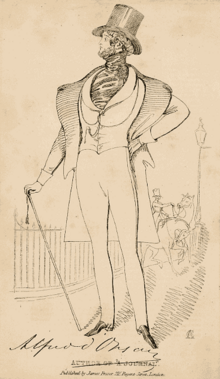Alfred d'Orsay
Alfred Guillaume Gabriel Grimaud, comte d'Orsay (born September 4, 1801 in Paris , † August 4, 1852 in Chambourcy , Île-de-France ) was a French caricaturist ( pseudonym N.B. ) and dandy .
Life
Alfred Guillaume Gabriel Grimaud was the second son of the Bonapartist general Jean-François-Louis-Marie-Albert Grimaud, comte d'Orsay (1772-1843) and his wife Eleonore Freiin von Franquemont (1771-1833), an illegitimate daughter of Duke Carl Eugen von Württemberg with the Italian adventurer Anna Eleonora Franchi.
In 1821, Grimaud joined the French army of the restored Bourbon monarchy , against his own Bonapartist tendencies. A year later he took part in the lavish coronation of George IV in Westminster Abbey and later served in the Guard du Corps of King Louis XVIII. During his station time in Valence he made the acquaintance of the English aristocrat Charles John Gardiner, 1st Earl of Blessington and his second wife, the writer Marguerite, Countess of Blessington ; At the Count's invitation, he accompanied the couple on their Grand Tour through Italy . In the spring of 1823 he met the famous poet Lord Byron in Genoa . After his return, the Comte d'Orsay became the darling of French and English society, especially women.
On December 1, 1827, the only 15-year-old Lady Harriet Gardiner (1812-1869) married the bon vivant Alfred d'Orsay for the second time. The marriage was not considered happy and soon existed only on paper. Two years later his patron and father-in-law died. During the transfer of his remains, he accompanied his widow, with whom he had a love affair , back to England .
Alfred d'Orsay and Lady Blessington ran a literary and artistic salon in London's Gore House on Kensington Road, where intellectuals , artists and fashion enthusiasts met. The visitors included Charles Dickens , Benjamin Disraeli , Thomas Lawrence , Alfred de Vigny , Alphonse de Lamartine , Prince Charles-Louis-Napoléon Bonaparte and Edward Bulwer-Lytton, 1st Baron Lytton - opponents of Lord Byron were excluded. In early 1838, Lady Harriet formally separated from her husband and paid his creditors £ 100,000 in exchange for his waiver of all claims on the family's Blessington Estate . When Lady Blessington's book sales diminished, and after Lady Blessington's legacy had been used up in their extravagant lifestyle together, the couple left England. Lady Blessington and the Count moved to Paris in 1849, where she died a few weeks after their arrival.
In 1852 Alfred d'Orsay was through his early friendship with Napoléon III. proposed the post of director at the École des Beaux-Arts . A few days after his official appointment, Alfred d'Orsay died of complications from a vertebral infection in the house of his sister Ida, Duchesse de Gramont.
The "d'Orsay" perfumery
Upon his death, Alfred d'Orsay left behind a valuable collection of perfumes he had created himself . In 1865, his heirs opened a perfumery in Neuilly-sur-Seine . In 1908 the company was converted into a corporation, the majority of which belonged to the Dutchman M. van Dyck, the Germans Sally Berg and Siegfried Berg and the Russian Léo Fink. She had a particular success with the brand Étiquette bleue . During the First World War, the company came to a sequester , the shares of the foreigners were taken over by the French and the company, which still exists today, was renamed Compagnie française des parfums d'Orsay .
literature
- Nick Foulkes: Last of the Dandies: The Scandalous Life and Escapades of Count D'Orsay , Thomas Dunne Books (2005) ISBN 0-312-27256-1
- Michael Sadleir: Blessington-d'Orsay , Constable ISBN 0-09-451750-9
Web links
Individual evidence
| personal data | |
|---|---|
| SURNAME | Orsay, Alfred d ' |
| ALTERNATIVE NAMES | Orsay, Alfred Guillaume Gabriel Grimaud comte d ' |
| BRIEF DESCRIPTION | French cartoonist |
| DATE OF BIRTH | September 4, 1801 |
| PLACE OF BIRTH | Paris |
| DATE OF DEATH | 4th August 1852 |
| Place of death | Chambourcy , Île-de-France |


